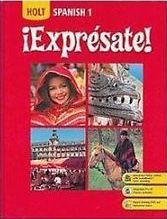
All Solutions
Page 32: Preparate para el examen
We also need to recall our vocabulary from early on in Chapter 1, where we learned that the word needed to introduce someone to a third party is also gendered: *éste* and *ésta*, male and female respectively.
The second part of the phrase will be *Ést(e/a) es (name).*
Hola. ¿Cómo estás? Ésta es Beatriz. Es de México. Éste es el señor Huang. Es de Estados Unidos. Éste es Antonio. Es de España.
subject + form of *ser* + description of subject.
The subject of the sentence is the proper noun (Rosa), while the latter half of the sentence “my best friend” describes who Rosa is. The verb *ser* (this time in the *él/ella* form) connects the two parts of the sentence.
subject + *ser* + description.
The subject of the first sentence is the proper noun (*la señora Cortez*). She is described as being the speaker’s Spanish teacher. The verb is the form of *ser* (in this case, the *él/ella* form) that connects the subject to the description.
The subject of the first sentence is the noun (this time not a proper noun), *el muchacho*. The verb *ser* (this time in the *él/ella* form) is connecting the subject with the description.
“(We) are from Costa Rica.”
“Hello Mr. Martínez. How are you?”
“Good, thank you, Jorge. And you?”
Here’s a little tip: In Spanish, tu and tú have different meanings. Which one will you use here? Tú means “you” and and tu means “your”. This is one of many instances where a missing accent drastically changes the meaning of the sentence.
“Where are Juan and Susana from?”
“(They) are from Bolivia.”
*punto* = dot (as in “.com”)
*arroba* = @
“a-a-ere-o-ene punto ere-o-de-ere-i-ge-u-e-zeta arroba ere-e-de punto hache-ere-uve doble punto a-ere.”
Look back on page 18 for a refresher on numbers in Spanish if you need it.
“Es dos-uno-dos-siete-ocho-nueve-cero.”
“Es el treinta y uno de octubre.”
– The time (ex. 1:15).
– The time of day (“in the afternoon”)
“Son las dos menos cuarto de le tarde.”
–Mucho gusto. Me llamo Luis.
–Mucho gusto.
–¿De dónde eres?
–Soy de España. Y tú, ¿eres de Miami?
–Sí, soy de Miami. ¿Qué hora es?
–Son las dos en punto.
This activity is related to the way we present ourselves courteously to another person.
– **Partner A:** Greet your partner and introduce yourself. Ask him or her name.
| Spanish| English|
|–|–|
| Hola, Bienvenido (a). Soy Manuel Terán, presidente del Club de Español. ¿Cómo te llamas?|Hello, Welcome. I am Manuel Terán, president of the Spanish Club. What’s your name? |
– **Partner B:** Tell your partner you´re pleased to meet him or her and say your name.
| Spanish| English|
|–|–|
| Encantada de conocerte. Me llamo Carmen Sánchez.| Nice to meet you. My name is Carmen Sánchez.
– **Partner A:** Ask where your partner is from.
| Spanish| English|
|–|–|
| ¿De dónde eres?| Where are you from?
– **Partner B:** Respond, then ask where your partner is from.
| Spanish| English|
|–|–|
| Soy de Caracas, Venezuela. ¿Y tú?| I’m from Caracas, Venezuela. And you?
– **Partner A:** Respond, then ask your partner’s e-mail address and phone number.
| Spanish| English|
|–|–|
| Yo soy Mexicano, nací en Ciudad de México. Necesito tu correo electrónico y tu teléfono, ¿podrías darmelos, por favor?| I am Mexican, I was born in Mexico City. I need your email and phone, could you please give them to me?
– **Partner B:** Answer your partner’s questions.
| Spanish| English|
|–|–|
| Sí, con mucho gusto. Mi correo electrónico es [email protected] y mi número de teléfono es 5-25-19-34.| Yes, with pleasure. My email is [email protected] and my phone number is 5-25-19-34.
– **Partner A:** Say you have to go. Say goodbye.
| Spanish| English|
|–|–|
| Muchas gracias, fue un placer conocerte. Ahora debo irme, tengo una clase en cinco minutos. Chao.| Thank you very much, it was a pleasure meeting you. Now I have to go, I have a class in five minutes. Bye.
– **Partner B:** Say goodbye. Say you’ll see him or her tomorrow.
| Spanish| English|
|–|–|
| El placer es mío. Chao, nos vemos mañana, si Dios quiere.| The pleasure is mine. Bye, see you tomorrow, God willing.

